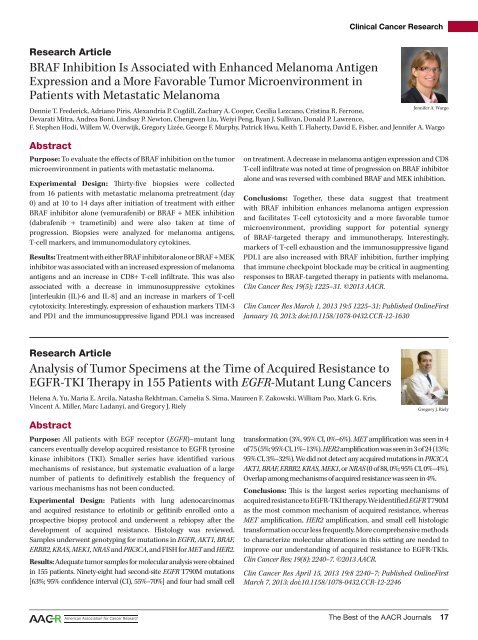Best of AACR Journals
Create successful ePaper yourself
Turn your PDF publications into a flip-book with our unique Google optimized e-Paper software.
Clinical Cancer Research<br />
Research Article<br />
BRAF Inhibition Is Associated with Enhanced Melanoma Antigen<br />
Expression and a More Favorable Tumor Microenvironment in<br />
Patients with Metastatic Melanoma<br />
Jennifer A. Wargo<br />
Dennie T. Frederick, Adriano Piris, Alexandria P. Cogdill, Zachary A. Cooper, Cecilia Lezcano, Cristina R. Ferrone,<br />
Devarati Mitra, Andrea Boni, Lindsay P. Newton, Chengwen Liu, Weiyi Peng, Ryan J. Sullivan, Donald P. Lawrence,<br />
F. Stephen Hodi, Willem W. Overwijk, Gregory Lizée, George F. Murphy, Patrick Hwu, Keith T. Flaherty, David E. Fisher, and Jennifer A. Wargo<br />
Abstract<br />
Purpose: To evaluate the effects <strong>of</strong> BRAF inhibition on the tumor<br />
microenvironment in patients with metastatic melanoma.<br />
Experimental Design: Thirty-five biopsies were collected<br />
from 16 patients with metastatic melanoma pretreatment (day<br />
0) and at 10 to 14 days after initiation <strong>of</strong> treatment with either<br />
BRAF inhibitor alone (vemurafenib) or BRAF + MEK inhibition<br />
(dabrafenib + trametinib) and were also taken at time <strong>of</strong><br />
progression. Biopsies were analyzed for melanoma antigens,<br />
T-cell markers, and immunomodulatory cytokines.<br />
Results: Treatment with either BRAF inhibitor alone or BRAF + MEK<br />
inhibitor was associated with an increased expression <strong>of</strong> melanoma<br />
antigens and an increase in CD8+ T-cell infiltrate. This was also<br />
associated with a decrease in immunosuppressive cytokines<br />
[interleukin (IL)-6 and IL-8] and an increase in markers <strong>of</strong> T-cell<br />
cytotoxicity. Interestingly, expression <strong>of</strong> exhaustion markers TIM-3<br />
and PD1 and the immunosuppressive ligand PDL1 was increased<br />
on treatment. A decrease in melanoma antigen expression and CD8<br />
T-cell infiltrate was noted at time <strong>of</strong> progression on BRAF inhibitor<br />
alone and was reversed with combined BRAF and MEK inhibition.<br />
Conclusions: Together, these data suggest that treatment<br />
with BRAF inhibition enhances melanoma antigen expression<br />
and facilitates T-cell cytotoxicity and a more favorable tumor<br />
microenvironment, providing support for potential synergy<br />
<strong>of</strong> BRAF-targeted therapy and immunotherapy. Interestingly,<br />
markers <strong>of</strong> T-cell exhaustion and the immunosuppressive ligand<br />
PDL1 are also increased with BRAF inhibition, further implying<br />
that immune checkpoint blockade may be critical in augmenting<br />
responses to BRAF-targeted therapy in patients with melanoma.<br />
Clin Cancer Res; 19(5); 1225–31. ©2013 <strong>AACR</strong>.<br />
Clin Cancer Res March 1, 2013 19:5 1225–31; Published OnlineFirst<br />
January 10, 2013; doi:10.1158/1078-0432.CCR-12-1630<br />
Research Article<br />
Analysis <strong>of</strong> Tumor Specimens at the Time <strong>of</strong> Acquired Resistance to<br />
EGFR-TKI Therapy in 155 Patients with EGFR-Mutant Lung Cancers<br />
Helena A. Yu, Maria E. Arcila, Natasha Rekhtman, Camelia S. Sima, Maureen F. Zakowski, William Pao, Mark G. Kris,<br />
Vincent A. Miller, Marc Ladanyi, and Gregory J. Riely<br />
Gregory J. Riely<br />
Abstract<br />
Purpose: All patients with EGF receptor (EGFR)–mutant lung<br />
cancers eventually develop acquired resistance to EGFR tyrosine<br />
kinase inhibitors (TKI). Smaller series have identified various<br />
mechanisms <strong>of</strong> resistance, but systematic evaluation <strong>of</strong> a large<br />
number <strong>of</strong> patients to definitively establish the frequency <strong>of</strong><br />
various mechanisms has not been conducted.<br />
Experimental Design: Patients with lung adenocarcinomas<br />
and acquired resistance to erlotinib or gefitinib enrolled onto a<br />
prospective biopsy protocol and underwent a rebiopsy after the<br />
development <strong>of</strong> acquired resistance. Histology was reviewed.<br />
Samples underwent genotyping for mutations in EGFR, AKT1, BRAF,<br />
ERBB2, KRAS, MEK1, NRAS and PIK3CA, and FISH for MET and HER2.<br />
Results: Adequate tumor samples for molecular analysis were obtained<br />
in 155 patients. Ninety-eight had second-site EGFR T790M mutations<br />
[63%; 95% confidence interval (CI), 55%–70%] and four had small cell<br />
transformation (3%, 95% CI, 0%–6%). MET amplification was seen in 4<br />
<strong>of</strong> 75 (5%; 95% CI, 1%–13%). HER2 amplification was seen in 3 <strong>of</strong> 24 (13%;<br />
95% CI, 3%–32%). We did not detect any acquired mutations in PIK3CA,<br />
AKT1, BRAF, ERBB2, KRAS, MEK1, or NRAS (0 <strong>of</strong> 88, 0%; 95% CI, 0%–4%).<br />
Overlap among mechanisms <strong>of</strong> acquired resistance was seen in 4%.<br />
Conclusions: This is the largest series reporting mechanisms <strong>of</strong><br />
acquired resistance to EGFR-TKI therapy. We identified EGFR T790M<br />
as the most common mechanism <strong>of</strong> acquired resistance, whereas<br />
MET amplification, HER2 amplification, and small cell histologic<br />
transformation occur less frequently. More comprehensive methods<br />
to characterize molecular alterations in this setting are needed to<br />
improve our understanding <strong>of</strong> acquired resistance to EGFR-TKIs.<br />
Clin Cancer Res; 19(8); 2240–7. ©2013 <strong>AACR</strong>.<br />
Clin Cancer Res April 15, 2013 19:8 2240–7; Published OnlineFirst<br />
March 7, 2013; doi:10.1158/1078-0432.CCR-12-2246<br />
The <strong>Best</strong> <strong>of</strong> the <strong>AACR</strong> <strong>Journals</strong> 17



